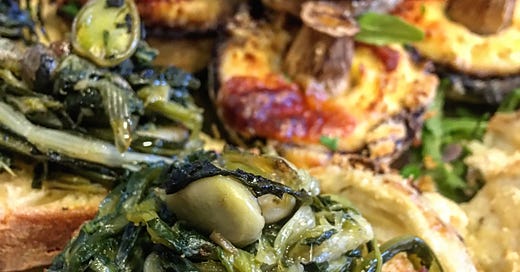Clearing our mental gardens for spring
and a recipe for bitter greens and fava bean crostini to welcome spring
My garden is bursting with happiness.
I can practically hear the tiny shoots giggling as they wiggle their way up through the sullen cracked brown winter earth. It seems almost impossible to understand the determination and imagination of those shoots. For how can those fragile slender things push mightily through the earth with such ease?
And how do they survive the lashings of April rain, the threat of unexpected frost, the impossible hail that Spring, temperamental to the end, flings at them?
Really it shouldn’t come as a surprise. After all, our minds work in very similar ways, pushing up thoughts from a deep bed of unconsciousness, tenacious shoots with deep roots. But, like our gardens, it’s hard at first to distinguish the wheat from the chaff. Our mental shoots don’t always produce healthy vigorous thoughts. Sometimes they’re like those insidious weeds that, left unchecked, can quickly take over and dominate, withstanding the attempts to quell them. It doesn’t help when we feed them with mental MiracleGro.
Weeds are pulled up by the roots to clear the fields for the growing grain. Why should not mental weeds be pulled up by the roots also, and the mind cleared for growth?
~Horace Fletcher, Menticulture, 1895
Like any living thing, what is nurtured, grows. So it is with our living, breathing thoughts. And with so many seeds of discontent planted in these past two years, our mental gardens run the risk of being overgrown with nettles, choking out the more timid lilies of the valley.
Yet nature is wise, and we would do well to observe her more subtle lessons. As Ralph Waldo Emerson said, a weed is a plant whose virtues have not yet been discovered (read here about why dandelions are a wonderful addition to your garden, and your table). So with our errant, seemingly negative thoughts. Left unchecked, they can overrun the garden of our minds. Yet if we go to the root, we may unearth the seed that is worth examining and giving air to.
The truth is that my garden is well prepared for whatever comes its way. It knows that, while nothing about Spring is certain, what is certain is that the days will grow longer, the sun will grow warmer and a glorious blooming lies ahead - for both flowers and weeds alike. Inevitably those ups and downs make it stronger, more resilient, lush and gorgeous.
As I carefully clear winter’s debris away and make room for this new cycle of life, I’m paying attention to all the shoots, judiciously watering, pulling out what no longer serves me, and letting the most positive shoots grow wild.
Crostini with bitter greens and fava beans
serves 6 as an appetizer
I’ve always loved bitter greens - something I think Italians are genetically programmed to enjoy. Arugula was part of my diet long before it became a trendy salad staple, and rapini and cicoria were the norm. But it was when I spent 10 weeks in Sicily that my love and appreciation for bitter greens became a bit of an obsession.
Food and religion intertwine sinuously in Italy, with every religious feast day having its own celebratory spread. In Sicily, the first bitter greens of spring are used copiously for the Festa di San Giuseppe, and through the year until the last wisp is gone.
This very simple preparation of bitter greens shines on crostini. Any combination of greens will work - use what’s available and what you like best. If you’re feeling adventurous, try something new, like dandelion greens (my favourite), or mustard greens, chicory or arugula.
Note: If you are using a very bitter green, like dandelion or spicy arugula, you can blanch the greens for a minute or two to leach some of the bitterness out.
Ingredients
One bunch bitter greens: dandelion, chicory, mustard or arugula, trimmed, washed and drained
2 tablespoons olive oil, plus more for crostini
2 fillets anchovies, either salted or preserved in olive oil, finely chopped. If using salted anchovies, rinse and drain on paper towels before using.
One clove garlic, finely minced, plus one clove, halved
1 tablespoon preserved lemon rind, finely chopped
⅓ cup cooked fresh or frozen fava beans (see how to cook fresh fava beans here)
Salt and freshly ground pepper, to taste
One baguette, cut into slices and toasted
Blanch the bitter greens for two minutes (see headnote), drain and dry in a salad spinner or on paper towels.
Cut the bitter greens crosswise, into lengths of about 4 inches. If using arugula, do not chop. Set aside.
Heat the olive oil in a medium skillet over medium heat. Add the anchovies, garlic and preserved lemon and sauté for 1 minute, or until fragrant. Take care not to brown the garlic.
Add the greens and sauté until the greens are cooked and soft, about 5-7 minutes, stirring while they cook. Be sure the greens are thoroughly softened. Stir in fava beans to combine. Season with salt and pepper. Set aside to cool.
Slice the baguette and rub half a garlic clove on each slice. Brush lightly with olive oil and toast on a grill or in the oven, 1-2 minutes per side, or until golden.
To serve, spread the bitter greens mixture on prepared crostini. Be sure a fava bean or two sits atop each crostini. Serve with a crisp white wine, preferably a delicious Grillo from Sicily.
The greens can be prepared in advance. Refrigerate to hold and bring to room temperature before assembling the crostini.






Such an eloquent read! It’s going into winter here, but now I can’t wait for spring. And I can’t wait to try the crostini! 💚